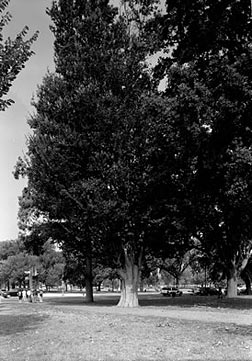
Washington, D.C.
Elms of the National Mall
Courtesy National Park Service
history (Botanic Garden “Elm”)
Union Square, on the eastern end of the National Mall, is bounded by Pennsylvania Avenue NW on the north, First Street NW and SW on the east, Maryland Avenue SW on the south, and Third Street NW and SW on the west. The trapezoidal parcel, just west of the United States Capital, was included in Pierre Charles L’Enfant’s 1791 design of the city of Washington, D.C. L’Enfant’s plan focused on combining a rectilinear street grid with open boulevards that visually connected prominent sites and structures to be erected within the new city. Two views were of paramount import to the plan. The first centered on Pennsylvania Avenue between the Capital and the “president’s house,” while the second extended the axes of the buildings to the west and south. This second vista, L’Enfant’s “Grand Avenue,” was designed as one large, open green space. However, little was done to realize L’Enfant’s vision during the 19th century, as buildings and temporary structures were erected on and around the Mall, effectively destroying the original panoramic design.
The first construction project on what is now known as Union Square took place in 1820. At that time, Congress authorized the Columbian Institute for the Promotion of Arts and Sciences to found the first United States Botanic Garden on the site. That same year, five acres of land were fenced in and the first greenhouses and gardens were established. Throughout the 19th century, the Botanic Garden continued to grow and develop, and became well known for its immense collection of trees and plants. Although many of the trees planted at the garden were common natives of the United States, the collection included some rare species, such as the Botanic Garden “Elm” (Zelkova carpinifolia), and significant memorial trees. Unfortunately, many of the exotic specimens have not survived to the present day and historic documents suggest that not one of the memorial trees remain.